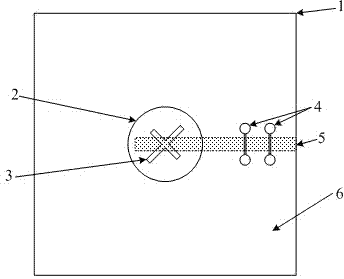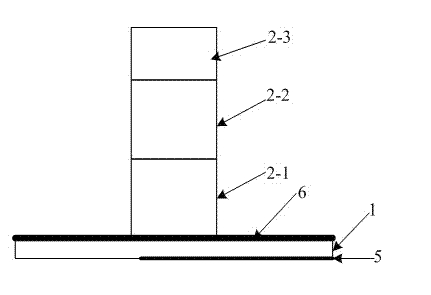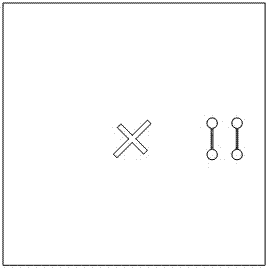Ku-band circularly polarized dielectric resonator antenna
A dielectric resonator and Ku-band technology, applied in the field of Ku-band circularly polarized dielectric resonator antennas, can solve the problems of high antenna cost, large volume, inconvenient use, etc., and achieve the effect of small antenna size
- Summary
- Abstract
- Description
- Claims
- Application Information
AI Technical Summary
Problems solved by technology
Method used
Image
Examples
Embodiment 1
[0023] see Figure 1~Figure 3 , the Ku-band circularly polarized dielectric resonator antenna includes a layer of gold on the upper surface of the dielectric substrate (1)
[0024] It belongs to the ground plate (6) and a microstrip feeder (5) on the lower surface of the dielectric substrate (1), and is characterized in that:
[0025] 1) There is a three-layer stacked dielectric resonator (2) at the center above the metal ground plate (6);
[0026] 2) There is a cross gap (3) at the center of the metal grounding plate (6);
[0027] 3) The inner end of the microstrip feeder (5) is directly below the cross slit (3), and the microstrip feeder and the cross slit (3) are at an angle of 45°;
[0028] 4) There are two cascaded dumbbell-shaped slots (4) on the metal ground plate (6) to widen the impedance bandwidth of the antenna.
Embodiment 2
[0030] This embodiment is basically the same as Embodiment 1, and the special feature is: the three-layer stacked dielectric resonator (2) is a lower dielectric cylinder (2-1), a middle dielectric cylinder (2-2) and an upper dielectric cylinder ( 2-3) Stacked, three layers of dielectric cylinders have the same radius, different materials and heights, the main effect of their height and the dielectric constant of the material on the antenna is the resonant frequency of the antenna, and its size affects the axial ratio bandwidth of the antenna Greater impact. The three-layer stacked circularly polarized dielectric resonator (2) is coupled and fed by the microstrip feeder (5) through the cross gap (3) in the center of the metal ground plate (6); the length of the two arms of the cross gap (3) Not equal, equal width. Left-handed or right-handed circular polarization is realized by controlling the length of the two slits. The smaller the width of the dumbbell handle of the dumbbe...
Embodiment 3
[0032] This embodiment is basically the same as Embodiment 1, and the special features are as follows:
[0033] 1. The structure of the antenna is as follows: Figure 1-2 As shown, the lower layer is the microstrip feeder (5), the middle layer is the dielectric substrate (1), and the microstrip feeder with a characteristic impedance of 50 ohms is etched on the dielectric substrate layer; the upper layer is the ground plate (6), the cross slit (3) and The dumbbell-shaped slots (4) are all slotted on the grounding plate (6); the lower medium cylinder (2-1); the middle medium cylinder (2-2); the upper medium cylinder (2-3).
[0034] 2. Three-layer stacked dielectric resonators (3) have the same dielectric radius but different materials and heights. Their height and dielectric constant mainly affect the resonant frequency of the antenna, and their size has a great influence on the axial ratio bandwidth of the antenna.
[0035] 3. The ground plate (6) and the microstrip feeder (5...
PUM
| Property | Measurement | Unit |
|---|---|---|
| Axial ratio | aaaaa | aaaaa |
Abstract
Description
Claims
Application Information
 Login to View More
Login to View More - R&D
- Intellectual Property
- Life Sciences
- Materials
- Tech Scout
- Unparalleled Data Quality
- Higher Quality Content
- 60% Fewer Hallucinations
Browse by: Latest US Patents, China's latest patents, Technical Efficacy Thesaurus, Application Domain, Technology Topic, Popular Technical Reports.
© 2025 PatSnap. All rights reserved.Legal|Privacy policy|Modern Slavery Act Transparency Statement|Sitemap|About US| Contact US: help@patsnap.com



